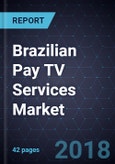Economic Crisis and New Consumer Demands Severely Impact the Business Outlook
In 2016 and 2017, the economic crisis and political instability severely affected our forecasts. Throughout 2018, the basic interest rate is expected to continue declining and forecasts of agribusiness crops have positive GDP expectations. Inflation and interest rates in decline will enable the return of foreign investments.
As the payback period is long for Pay TV services, and considering that an installation requires different equipment, a technician on site, and infrastructure, DTH operators started becoming strict in their credit analysis for new additions. This means that millions of prospects were denied. Furthermore, operators faced disconnections from families cutting household spending due to the economic crisis.
The Pay TV market is impacted directly by the by the growth of the middle class and its spending power. With 65% of families in debt, record unemployment, and the government cutting benefits, the industry has suffered. Once the consumption of families and businesses recovers, the Pay TV sector will also benefit.
After six years of slowdown, including two of recession, Brazil is growing again. However, the years of economic stagnation have halted social progress, and the country needs to spur its economic recovery and find new engines of growth to reduce poverty and boost prosperity. Stronger middle-class purchasing power would change consumption trends and increase discretionary spending, such as for Pay TV services.
The World Cup is expected to increase awareness on Pay TV services in 2018. This is expected to create new opportunities for exchange TV sets and increased demand for image quality. However, the market will fully recover and start to grow again only in 2019, after the public elections and economic stabilization.
The author’s forecast indicated that the market can reach 19.8 million Pay TV subscriptions in 2022, with a compound annual growth rate (CAGR) of 2.4% from 2017 to 2022.
Research Scope
This study provides market sizing information, in terms of subscribers, for the Pay TV services market in Brazil. The base year is 2017, with forecasts running through 2022. The market is further divided into technologies such as cable TV, direct-to-home (DTH), multichannel multipoint distribution service, and Internet protocol TV. It also includes an analytical breakdown by segment (residential and B2B), by resolution (SD and HD), payment method (prepaid, postpaid, and free-to-air), by bundles (1P, 2P, 3P and 4P), and VOD subscribers.
Geographic scope: Brazil
Stakeholder scope: Multiple-system operator (MSO), cable operators, local cable operator (LCO), and DTH operators
Key Issues Addressed
- What are the growth opportunities for Pay TV services in Brazil?
- What are the subscription growth opportunities for cable, IPTV, and DTH services respectively?
- What are the major drivers and restraints for the Pay TV market in Brazil?
- What are the estimated forecasts of subscribers for high-definition, prepaid, and VOD sectors?
- What are the estimated forecasts for standalone and bundled services for the telecommunications services market?
Key Conclusion
IPTV will have the biggest growth as DTH and cable TV lost a significant amount of subscribers in 2017 and will probably continue losing subscribers in 2018. Other drivers that will help the market to recover are HD resolution, which should be at 91.1% of subscribers in 2022; the prepaid method, which has a significant opportunity in low-income segments and as an alternative for summer/winter households; bundles-mainly 3P and 4P will have the greatest impact on the market; and VOD, which is already included in most offers but will be expanded. The growing demand for movies and television shows at a convenient time for the viewer, rather than during the scheduled broadcast time, is increasingly stimulating VOD services, especially with catch-up features, which are usually free. All major Brazilian Pay TV providers have been investing in developing their own VOD platforms to gain new premium subscribers and increase their average revenue per user (ARPU).








